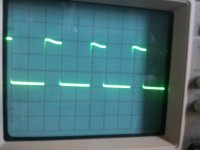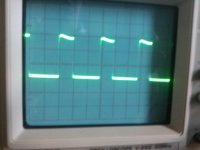I'm almost ready with the SMPS board, now I'm starting the transformer winding. Can you check my calculations please? I made them based on a pdf file you have posted before.
so Npri= (Vnom*10^8)/(4*f*Bmax*Ae) : From the ETD datasheet Ae is 2,12 cm^2, f is 70 kHz . The core material is ASTM P5025 ( TSF50 ) power ferrite, I got it from ebay, they say that Bmax is 500 mT, but I can't find any datasheet. There are some diagrams but I couldn't find the one you have in the pdf example. So I used Bmax= 300mT and the result was 14 039, I guess that means 14 turns. For secondary I used Ns=(Np*Vs/Vp), Vp=160V, Np=14 turns and Vs is 63V (to get 90V rectified) So it gives 5,56 turns. Did I do something wrong, because these values seem too small for me.
Thank You!
My calculations:- based on 150V @70Khz ETD49 (Ae 2.11) Bmax 1000, Result is 25 Turns for primary, Use 24 Turns.
* For 90V output (Single output) you will need around 14.5 turns. for 90 - 0 -90 you need 14.5 -0- 14.5 turns.
Above values are 95% accurate, depends on input voltage variations. Try them. 14 Turns are too small for ETD49 @ 70Khz, its because you have use high Bmax into your calculations!
I have another question about the winding order: I start with:
half of primary,
3 layers of tape,
half secondary for 63V (90Vdc),
2 layers of tape,
half secondary for 12V,
2 layers of tape
half sec for 12V,
2 layers of tape,
half sec for 63V,
3 layers of tape,
half primary
finally 3 layers of tape.
You can do, All primary then All secondaries. This is good as a start. and simple.
use 3 Layers MINIMUM of mylar tape between primary and secondary. Also PUT isolation tape BETWEEN secondaries !
Also, winding in the way you mentions is Also 100% perfect!
I hope it will fit this way, if not, can I put the two winding for 12V in one row?
Yes
For the output I bought 4700uF 100V capacitors, low esr. Are these enough? I will use the smps for an audio amlifier, that's why I bought this big capacitance.
This is good value, but it may trigger protection circuit at first because its big, please try to locate 2x1000uf 100V in order to test the SMPS, if you cant we can deal with this.
If I succeed to finish today, tomorrow I go to the university to test the SMPS. Can you tell me some info how to test it?
1- Make AUX supply working
2- Assemble the SG3525 section and make sure its working
3- Show waves at output of SG
4- Put IR2110 chip
5- Check waves for IR2110, and show waves
6- Solder mosfets, DONT APPLY high voltage AT ALL
7- Show waves of S+G of each Mosfet, DONT FEED HIGH VOLTAGE
when you show process to step 7 , will tell how to complete, this is for your safety
Is i planned, I won't solder the transformer, the the irfp-s and the output capacitors and I test the output of the IR2110 with the scope. I plan to feed the IC from DC sourceat this stage. I'll take pictures and post it. If it's OK, I solder the FET-s and the transformer.
I have a 300W transformer with 56V AC output to connect to the input of the SMPS. Then I test the output voltage. Does that transformer give enough voltage to setup the smps?
This transformer is best for testing at safe voltage levels, NEVER connect SMPS to mains BEFORE confirming with me.
For the controlling IC-s I still use dc power source. Can you tell me how to set up the two trimmersfor the SG3525 and the protect board? Are the two trimmers for frequency and duty cycle?
please Ask uglykid about these things, he made it fully working!
Please help me in these questions. Thank you for your help!



